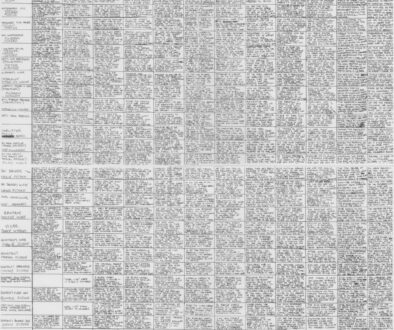Let Them Laugh (Book Three, Part Seventeen: Bill Finger, Tim Burton)
Previously in The Last War in Albion: Arkham Asylum was a hall of mirrors.
Why should I mind, Sam? Let them laugh. I am still their emperor. -Neil Gaiman, Sandman
When Batman pierces his hand to pull himself out of the trauma inflicted by the Joker he does so with a broken piece of mirror, while Arkham recounts his trauma in the funhouse hall of mirrors. And so the act of doubling is itself doubled. This approaches monstrosities far beyond those imagined by Borges, a point Arkham is aware of when he relates his nightmare “that the mirror people have escaped from the glass and come looking for me.” This, perhaps, is the dark and unspeakable inversion of Jung; that the Shadow might too need to confront the Self so that it can escape its bonds of repression.
Indeed, something very much like this happened. Arkham Asylum was not the book Morrison intended. Dave McKean did not draw the book Morrison wanted, not merely leaving out key elements of the symbolism but drawing a book whose starkly abstracted style was fundamentally incapable of communicating the sort of information Morrison wanted to communicate. The result is a bastard book, a monstrous thing that serves none of its creators’ purposes—a mirroring, as it were. But, of course, this is fitting for the book. Morrison’s point, after all, is that Batman finds himself reflected in the madmen within the asylum; that the implicate order of Batman means that truly understanding the Dark Knight requires understanding the madmen he fights. Surely a monstrous version of the book is, in some sense, its true form.

Indeed, in a very real sense Batman himself is a monstrous creation. The character was co-created by Bill Finger and Bob Kane. The latter, attempting to copy the success of Superman, drew a character to be called “The Bat-Man.” The original version featured a domino mask, literal bat-wings (although he was also swinging from a rope), and a costume design with large numbers of red highlights. Bill Finger, looking at the design, suggested the iconic cowl, the use of a cape, and removing the red elements of the costume, and also served as writer on the project, creating the name Bruce Wayne and Batman’s alter-ego, going on to write the debuts of Gotham City, the Batcave, the Batmobile, Robin, the Joker, Catwoman, the Riddler, the Penguin, Two-Face, Scarecrow, Mad Hatter, Clayface, and more.

It was, however, Bob Kane who brought the character to DC, and so Bob Kane that negotiated the deal that would put his name on every issue as the sole creator, even as within a year he’d hired multiple art assistants and, subsequently, artists to ghost his style entirely. Finger, meanwhile, was pushed out of the picture, with Kane angrily denouncing his claims of having helped created Batman as fraudulent and declaring that if Kane wanted to be more than an anonymous ghost writer he would need to become a leader, not a follower. Kane parlayed his official status as the sole creator of Batman into a sort of sub-Stan Lee existence as a celebrity, including a sideline as an artist producing “fine art” for galleries, or more accurately hiring ghost artists to do it in his name. When he died in 1998 his gravestone offered the genuinely staggering account, “GOD bestowed a dream upon Bob Kane. Blessed with divine inspirationa nd a rich imagination, Bob created a legacy known as BATMAN. Introduced in a May 1939 comic book, Batman grew from a tiny acorn into an American Icon. A ‘Hand of God’ creation, Batman and his world personify the eternal struggle of good versus evil, with GOD’s laws prevailing in the end. Bob Kane, Bruce Wayne, Batman—they are one and the same, Bob infused his dual identity with his own attributes: goodness, kindness, compassion, sensitivity, generosity, intelligence, integrity, courage, purity of spirit, a love of all mankind. Batman is known as the ‘Dark Knight’ but through his deeds he walks int he Light of a Higher Power, as did his creator—Bob Kane!” Bill Finger, for his part, died in 1974 having never received credit on a single issue of Batman.
That such a character would serve as the basis for a monstrous story such as Arkham Asylum was, in other words, still more inevitable. Morrison and McKean, by creating a lunar dreamscape where Batman’s unconscious could be explored, released monsters. This may not have been what either intended, but it was the inevitable consequence of the ideas they created. Arkham Asylum is a story in which the monsters get loose and show Batman how he is defined by them. What else could possibly have happened?

This notion of the mad and the monstrous serving as a revealer of higher truth is central to another one of Arkham Asylum’s foundational images, the Feast of Fools. This was a medieval festival originating in France, originally around the Feast of the Circumcision as part of the larger Christmas season. The Feast of Fools was a festival about inverting the “natural” order of things, featuring the electing of false clergy and a ritualized exchange where powerful clergy would assume lowly roles while lowlier sorts were elevated. Or, as Morrison put it when talking to Mark Millar in 1989, “These and other similar festivals involved day-long role reversals and high-born ladies were expected to learn a formal swearing etiquette in order to be able to play the parts of tarts for a day. You know, ‘I fuck. You fuck. We fuck. They fuck,’ and that sort of thing. So the story draws its initial inspiration from these celebrations where priests would hang around brothels and beggars would play the part of noblemen.” This is a somewhat bastardized understanding of the festival, rooted in the backlash against it that led to its being banned in the 15th century, but as with Triple Goddesses accurate history only tells part of the story.
Morrison’s account owes more to Russian theorist Mikhail Bakhtin’s notion of the carnivalesque, which he framed in terms of the Feast of Fools and a variety of other similar festivals. In Bakhtin’s formulation, the carnivalesque is a literary mode in which the structures of society are temporarily dismantled and inverted, revealing for a moment the arbitrary nature of those structures. But, crucially, the carnival in Bakhtin is a temporary inversion; the breakdown it reveals is always circumscribed by the inevitability of the party’s end and the restoration of order; uncrowning the Lord of Misrule was every bit as important to the ritual as his coronation.

An obvious point of similarity is, of course, the Moon, whose shadowy space of unconscious desires let loose marks off a distinctly carnivalesque space, albeit one that need not be as open-ended. The similarity is well-illustrated by Morrison’s Hellblazer two-parter, released a few months after Arkham Asylum. That story focuses on a festival described variously as pagan and a carnival during which the subconscious fears and darknesses of the town are brought to the forefront, complete with the crowning of “Archbishop Bomb,” a clear Lord of Misrule figure. And it is clear they intended something similar with Arkham Asylum—a story in which the madmen took over the asylum and revealed the arbitrary divide between themselves and Batman. As they put it in an interview prior to the book’s release, “The story draws its inspiration from the medieval Feast of Fools and the World-Turned-Topsy-Turvy ceremonies when the rich would swap places with the beggars, criminals would become clergy and they’d all enjoy a day-long orgy of role-playing. So we look at all the familiar Batman paraphernalia from the viewpoint of these insane villains.” But the limitations of this are clear, just as they were in Bakhtin. The normal order of things must be restored, as in fact it is, and any revelations about Batman pushed back down beneath the surface so that Marv Wolfman and Alan Grant could get back to the monthly grind on Batman and Detective Comics.
Of course, in 1989 there was an even higher order than the regular comic books in play with Batman. In June of that year Warner Bros. released their film adaptation of Batman, the first film adaptation of the character since the 1966 Adam West film and the highest-grossing film in the US for 1989. Within the corporate structure of Warner Bros., a major film like this was of far higher priority than the comics, a low-selling medium that existed within the corporate structure more because it was an inexpensive thing to do with their IP farm than anything else. This was the new sun around all Batman must revolve, and Arkham Asylum was trapped in its orbit almost from the start. Morrison wrote the first draft of the script in 1987, but in April 1988 the film entered pre-production, and from that moment Morrison’s comic was a secondary concern. This did not simply cause issues like the removal of the Joker as Madonna concept, but led to the entire project being repeatedly delayed until it finally came out a safe three months after the film.

Although they developed independently, there were a number of similarities between Arkham Asylum and Batman. Tapped to direct the film was Tim Burton, who got the job off the back of his directoral debut, Pee-wee’s Big Adventure. The more indicative film, however was his 1988 horror comedy Beetlejuice, which established the whimsically gothic style that would quickly become Burton’s trademark. Within Batman this style is somewhat subdued (it would emerge more fully in the 1992 sequel), but it’s still unmistakably present, especially around Jack Nicholson’s portrayal of the Joker. Nicholson’s Joker, as one would expect from him, played the part with campy relish, which Burton was adept at situating in a carnivalesque visual aesthetic. A major sequence in which the Joker and his henchmen deface an art museum is fairly directly a Feast of Fools segment, with the Joker reveling in the overturning of the established and stodgy order of the art world over the soundtrack of Prince’s “Partyman.” But the film’s denouement, in which the Joker takes over Gotham’s television screens, usurping the Mayor’s press conference to announce a parade at which he’ll throw millions of dollars to the crowd, takes this even further. Despite his having recently been trying to kill everyone in Gotham via tainted beauty products, the people of Gotham enthusiastically embrace the Joker, at once a bitter satire and a clear passage into the realm of the carnivalesque.

Burton also found himself in similar territory to Morrison, or at least to Morrison’s intentions, with his choice of casting for Batman, Michael Keaton. Keaton was best known as a comedic actor, and his casting was immediately controversial among comics fans who feared the movie was going in a comedic direction. But to Burton’s mind the expected decision of casting a buff and imposing actor didn’t make sense—as he put it, “Why would this big, macho, Arnold Schwarzenegger-type person dress up as a bat, for God’s sake?” Instead, however, Keaton turned in a performance of tight-wound neurosis, playing Bruce Wayne as a scrawny and repressed man who became a hulking, brooding figure only when he put the suit on. (No small part of this was imposed by the costume design, a tight and claustrophobic suit that heavily restricted Keaton’s movement and prevented him from turning his head.) The result was not far from the sexually repressed, stiff, and anal Batman called for by Morrison.
As mentioned, Burton’s film was a smash hit, pulling in over $400 million. And as the author of a high profile hardcover graphic novel on shelves just three months later, Morrison reaped the benefits. As Morrison put it in SuperGods, “Initial orders were for 120,000 copies, with Dave and me on a dollar royalty for each.” They recall how Karen Berger called before release “and she just said ‘you’re rich,’ that was the first thing she said.” This was transformative money for them; “it got me out of a bedsit and into a house, and it paid for holidays, it allowed me to travel and do all sorts of things.” Morrison had, in short, made it on what was essentially their second major project. [continued]





August 2, 2021 @ 5:43 pm
…I think I’ve already recommended Infinity Train to you? Animated TV cartoon, formally for children but actually pretty complex, and goes to some very deep and dark places?
So in Season One, there’s a Mirror Car, where your reflection can be incarnated as a living counterpart to you. Protagonist Tulip’s reflection turns out to be hostile; she traps the protagonist in the mirror world, then makes a break for freedom. All predictable enough. But then…
1) Tulip and the reflection work out a solution that lets them both stay in the “Real” world; but,
2) the reflection has a very different personality from the original Tulip, and immediately takes off on her own; and,
3) the /entire second season/ of the show is about the reflection — “Mirror-Tulip” — and her quest for life, freedom and self-actualization; because
4) throughout the second season, Mirror -Tulip is pursued by the “Mirror Police”, who are extremely Morrisonian and whose purpose is to “fix” her; and,
5) oh yes, Mirror-Tulip is a trans boy. I mean SUCH a trans boy. It’s about as obvious as they could get away without actually coming out and saying so. Like, the first two minutes of the first episode of her season are about them cutting their hair very short and changing from Tulip’s shirt-skirt-sensible shoes outfit to jeans, boots and a torn black t-shirt.
so basically all of Season Two is about a stubborn, difficult trans person fleeing from the forces that want to fix the mistake that they are, and be free.
(and here’s how good this show was: it salted a bunch of very subtle clues that original protagonist Tulip might be queer or trans, but that this side of her was suppressed — making Mirror-Tulip pretty much the Jungian shadow made shiny chrome flesh.)
(oh and while the phrase “deadnaming” is never used, Mirror-Tulip hates being called Tulip, and it’s a major event when they finally do choose their own name.)
It’s so good, and it’s not that long — the eps are short, so you can watch an entire season in a couple of hours.
Anyway! Pray carry on.
Doug M.
October 21, 2021 @ 5:28 pm
Late but I second, third, and fourth the Infinity Train recommendation. It’s one of those pieces of media that genuinely raises the bar for the medium it appears in.